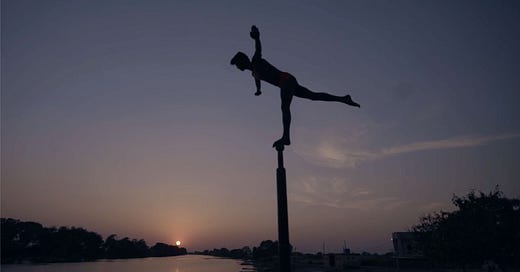Once upon a time, most yogis sat still. Meanwhile, wrestlers contorted their bodies – along with those of their opponents – into various shapes. To prepare, they developed techniques that honed strength and flexibility. One of them involved a long pole.
At various points in the last few centuries, these two disciplines traded ideas. One striking example is sun salutations, which focus on inhaling and exhaling through a sequence of postures. No yoga text teaches these movements before the modern era – they may have begun as a training drill used by wrestlers and other martial artists.
Since then, the practice of mallakhamb (a modern Indian name for the wrestler’s pole) has continued evolving. One variant, becoming more widespread, uses ropes instead of the traditional teak-wood cane. Groups also offer displays that resemble a mixture of synchronised swimming, postural yoga and gymnastics.
A new film by Philippa Frisby – The Wrestler’s Cane – explores both mallakhamb and its growing popularity thanks to Uday Desphande, a life-long teacher who organised the first world championship in 2019. Uday stars in the film (which is screening at SOAS in London on November 27 – get free tickets here), but would probably say its real stars are his students, whose lives have been transformed by their practice.
Keep reading with a 7-day free trial
Subscribe to Ancient Futures to keep reading this post and get 7 days of free access to the full post archives.




